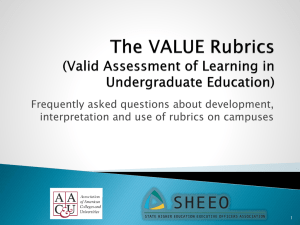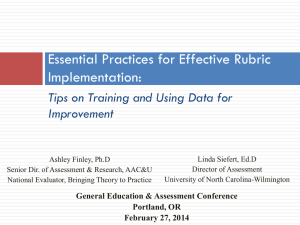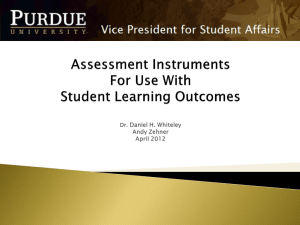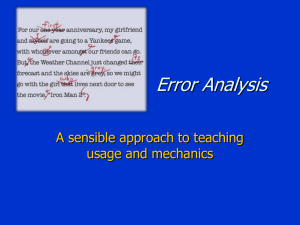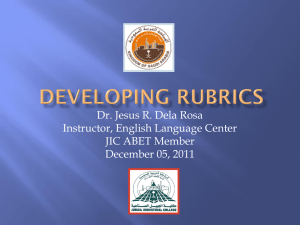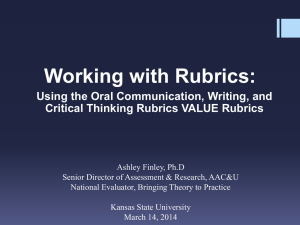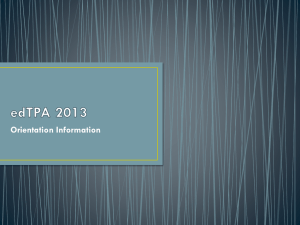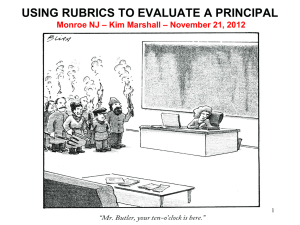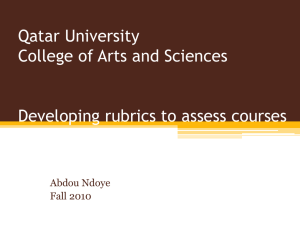An Introduction to Rubrics - Assessment
advertisement
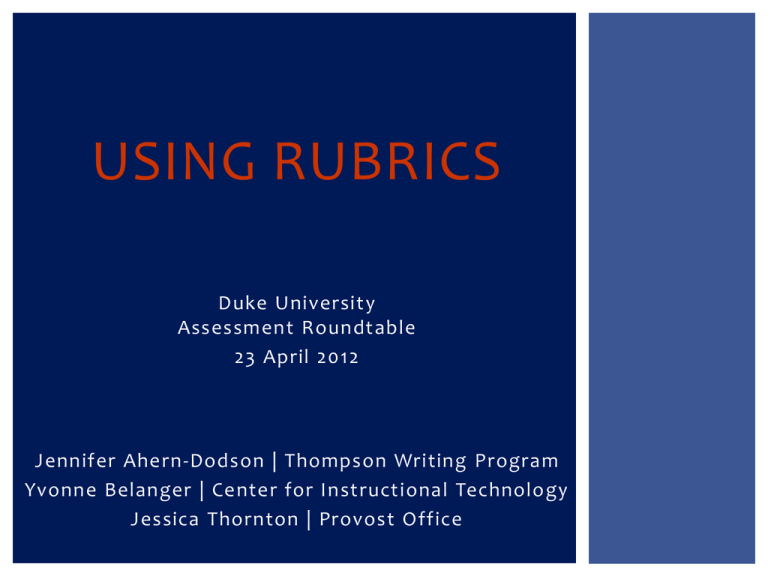
USING RUBRICS Duke University Assessment Roundtable 23 April 2012 Jennifer Ahern-Dodson | Thompson Writing Program Yvonne Belanger | Center for Instructional Technology Jessica Thornton | Provost Office RUBRICS: WHAT ABOUT THEM? Background Getting you Started - Audience Participation Examples from Across Duke Take-aways Question and Answer Sign-in! Handouts Available OVERVIEW: WHAT EXACTLY ARE RUBRICS? Word Root: Red Ink In the mid-90s reframed as a evaluation tool A scoring tool that lays out specific expectations for an assignment Divides assignment into its component parts Can include descriptions of acceptable and unacceptable performance OVERVIEW: WHY USE RUBRICS? Help with Grading Communicate Expectations to Students Sharing Best Practices Program Assessment OVERVIEW: COMPONENTS OF RUBRICS Task Description Dimensions Scale Description of Performance at each level and dimension OVERVIEW: EXAMPLES OVERVIEW: THINKING OUTSIDE THE BOX Rubrics are not necessarily: Quantitative Summative Tied to Grades Useful only at the assignment level Comprehensive Boring checklists GETTING YOU STARTED NAMING WHAT MATTERS What do you most care about students learning? How is this communicated to students (mission statement, syllabus, application)? What skills or experiences do they need to get there? GETTING SPECIFIC: WHAT WOULD SUCCESS LOOK LIKE? Name at least one learning goal and describe (or bullet list) what it would look like if students mastered that goal. Concept: “backwards design” ALIGNING FOR LEARNING What do you want students to be able to do by the end of the project/course?(Learning goals) How do you give them practice in those goals? (Teaching or Mentoring Strategies) How do you know that they are learning (in process) and have learned (at end) these goals? (Feedback strategies and evaluation) EXAMPLES FROM ACROSS DUKE EXAMPLES FROM DUKE: DIVINITY EXAMPLES FROM DUKE: FOREIGN LANGUAGE EXAMPLES FROM DUKE: BIOTAP EXAMPLES FROM DUKE: PRATT TAKE-AWAYS TAKE-AWAYS: HOW TO GET STARTED Start Small Start with one assignment Keep learning goals at center Scaffolding TAKE-AWAYS: HOW TO CREATE A RUBRIC Abundance of Rubrics on the Internet Easy to create and make your own Build consensus in your program or department RESOURCES AAC&U VALUE Rubrics Available at assessment.aas.duke.edu Book: Introduction to Rubrics (Stevens & Levi) Article: On the “Uses” of Rubrics: Reframing the Great Rubric Debate (Turley & Gallagher) THANK YOU! Questions? Thoughts? Feedback? MAKING IT YOURS: HOW TO BUILD IT? GET CONSENSUS? Subject Matter Expert Driven Interview faculty individually or in small groups Determine dimensions and descriptions of performance from interviews This approach may need assistance on the front-end MAKING IT YOURS: HOW TO BUILD IT? GET CONSENSUS? Ground up Approach Start with a blank rubric Ask faculty to score and make notes Rubric will evolve over time with feedback

